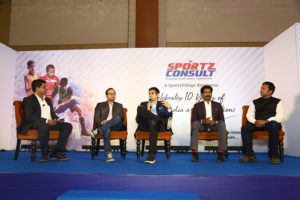SportzConsult is one of India’s premier sports management company that was founded by Jitendra Joshi in 2008. The company has grown over the years and are now celebrating 10 years of its existence. Based in Navi Mumbai, the company has delivered more than 500 events, creating opportunities to play for more than 1 million people every year.
To mark the occasion, the company gathered some of the top voices from the sports and marketing industry to come together and dive into the discussion of how the country can and must encourage sports and contribute to its dynamically growing sports economy.
Keep reading for a list of the Top Ten Experiential Sports Marketing Trends, as put down by Jitendra Joshi, Co-Founder and Director, SportzConsult:
“The recent wins at Commonwealth Games make every Indian’s chest swell with pride. We Indians are increasingly showing interest in sports beyond cricket. And this interest is observed at the grassroots level as well with participation numbers increasing every year.
- Working with Women: Support their efforts, win their hearts
Women are increasingly moving towards sports and brands are doing their best to support this shift. Brands are targeting this emerging spender through platforms like marathons, cyclothons, confidence training camps and fitness apps.
- Reaching a Rural Audience: Rural Marketing Through Sports
On-ground activations that involve sports are the new way marketers are reaching out to the rural consumer who has increasing purchasing power and aspirations. Hero MotoCorp created a multi-sport platform, Hero Grameen Khel Utsav, for school children in rural areas of Kolhapur. Popular local sports such as Kabaddi and Kho Kho were included so that kids could engage with the event, and brand, at an emotional level.
- Education through Sports: A Brand-New Route to School Contact Programmes
Brand engagement initiatives are being tailored to teach students something new to maintain the spirit of learning. The cue is increasingly being taken by marketers to engage children in schools with real value-added programmes. Mattel Scrabble recently conducted a program in which it connected with nearly 1 lac kids through a communication of improving English lexicon through Scrabble.
- The Millennial Shift Away from Marathons, to New Platforms – with a Twist
While the early 2000’s saw an inclination of millennials towards marathons and triathlons, some voices in the West have already begun to proclaim that the running boom is over. Brands are innovating by creating formats like colour runs, music marathons to keep-up the spirit of running and fitness in this generation.
- Amplifying Your Campaign’s Emotional Quotient: Go Digital
Social media incentives such as likes, shares & comments is motivating amateur sports people to participate more in sports. Brands are jumping onto this trend to keep their consumers hooked via creating social media content that engage consumers in conversations around sports.
- Using Technology with Sports: An Enhanced Participant Experience
Technology is enhancing the experience of amateur sports and diluting boundaries – thus, offering a platform to learn and excel at international sports. For example, Kevin Durant conducted the ‘World’s largest Basketball lesson’ from The NBA Academy India in New Delhi, while young basketball enthusiasts joined in via life-size screen live telecast from multiple cities across India.
- Assessments Make It Personal
Brands are trying their best to give consumers a personalized experience and enhance individual sports capacity. Nestlé Milo, for instance, positioned as a health drink, has created a special fitness band for children – their primary target consumer.
- Influencing Influencers: Working with local celebrities
In this unexplored territory, brands can find real gems to act as their local ambassadors. They bring heart to a campaign as no international celebrity could. These are unknown names at a national level, and hence more affordable than national stars, yet command an enviable popularity among a tight target audience. Nike uses a similar philosophy with the Nike Running Club. Local, mini celebrities are roped into be a part of the run club, who then promote the run club on their social media handles.
- Sports: A new differentiator in real estate
Sports infrastructure is increasingly becoming a differentiator for developers. Along with setting up sports amenities, they are also organising sports tournaments at their premises to attract potential customers to ‘sample’ the properties.
- Keep the Conversation Going:
Brands want to be part of the entire ‘consumer journey’ and not be a one-day activity. Sports programmes provide brands the means to engage consumers at regular intervals and for longer durations, providing an effective way to achieve this goal.
The certitude of innovation in sports marketing gives hopes for a ‘sportier future’ and a ‘sportier nation’.
About the author: Jitendra Joshi is the Co-founder and Director of SportzConsult – India’s premier experiential sports management company. SportzConsult has facilitated playing opportunities for over 4 Million Indians, including kids, youth, adults and corporate executives for the last ten years.




